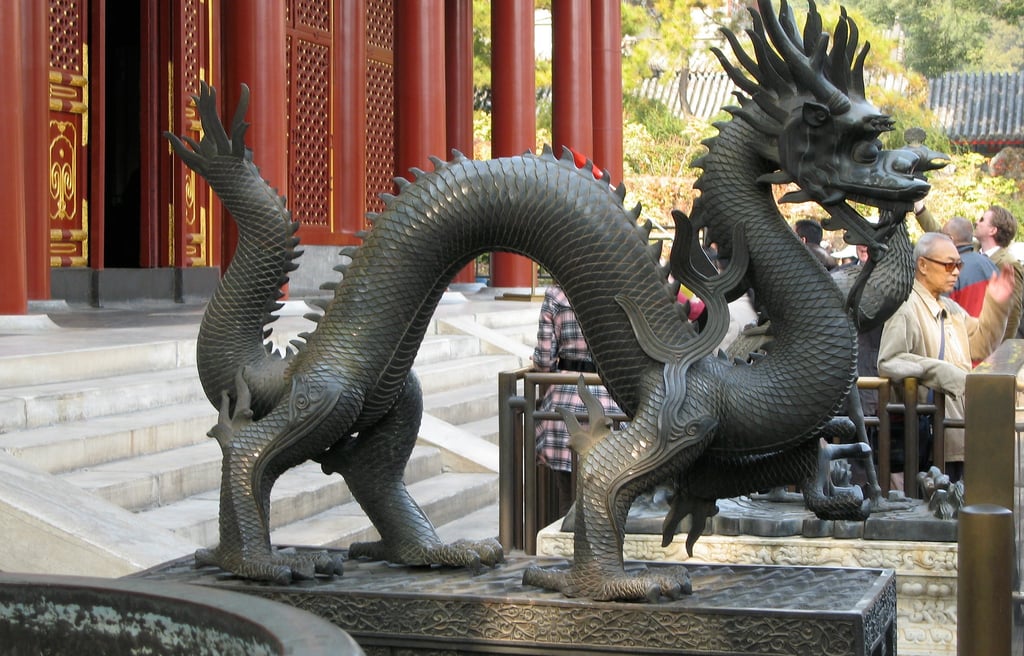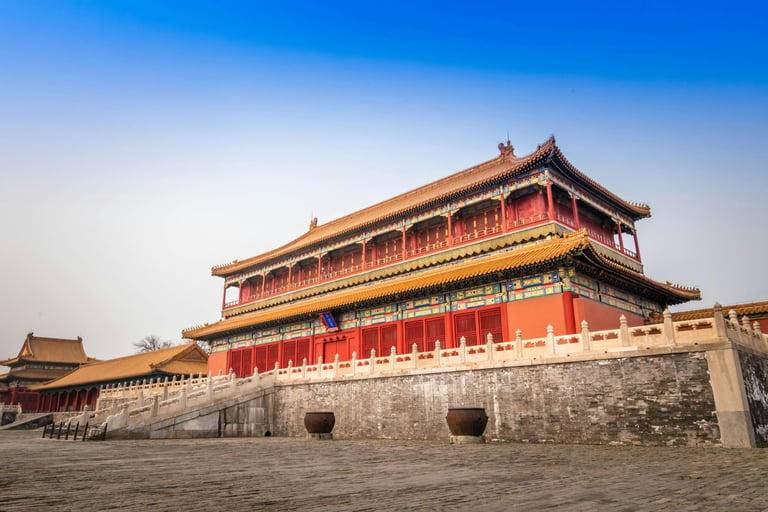Beijing – Dragon’s Breath
Experience Beijing, where imperial history, modern power, and ancient spirit rise together in the enduring breath of the dragon.
DESTINATIONS
Jetsclusive
6/29/20255 min read


Beijing: Dragon’s Breath of a Living Legend
Walk down any grand avenue or quiet lane in Beijing, and you’ll sense it—the city stirs, coils, and breathes with the mighty presence of the dragon. No simple mascot, this creature shapes Beijing’s story, anchors its traditions, and charges its daily pulse. From majestic imperial halls to buzzing street festivals, Beijing doesn’t just honor the dragon; it lives and breathes its legend. To know Beijing is to walk in the shadow of a myth come alive.
The Chinese Dragon: Symbolism, Myth, and Beijing’s Heritage
The dragon carved deep marks into Chinese identity, but Beijing became the chosen ground where myth hardened into marble and ceremony. More than fearsome beasts, Chinese dragons stand for power, wisdom, luck, and unity. Their image never meant destruction. Instead, the dragon calls rain, blesses rulers, stirs crops, and guards gates.
Historical Origins and Evolution of the Chinese Dragon
Archaeologists trace the Chinese dragon’s beginnings to totemic ancestors some 6,500 years ago. Early jade carvings mix the lines of snakes, fish, and crocodiles—a patchwork of mighty creatures. Over centuries, stories grew: ancient emperors, like Huang Di, traced their heritage to dragons and claimed the right to rule by “dragon veins” that laced China’s earth.
As tribal totems met imperial ambition, the dragon’s image sharpened. By the Qin and Han dynasties, the five-clawed dragon became the emperor’s badge alone—a clear sign of divine favor. Its power stretched from tomb mosaics all the way to palace rooftops and painted ceilings.
Dragons in China, unlike Western dragons, never spat fire and guarded gold. Instead, they ruled clouds, commanded rainfall, and—fittingly—breathed the life of empires.
Compare Private Jet Pricing To Beijing Here Powered By Villiers Jets - Trusted by 1000+ flyers worldwide
Imperial Beijing: Dragons as a Symbol of Authority and Power
Beijing, as China’s ancient and modern capital, displays dragon symbolism everywhere the eye lands. The Forbidden City, home to generations of emperors, sits at Beijing’s heart, a living monument to dragon worship. You’ll spot 9,999 decorative figures and golden dragons with five claws (the special number reserved only for the emperor) flashing on walls and ceilings.
Imperial robes sparkled with dragon embroidery. Only the emperor could wear the bright yellow robe clenched by a powerful five-clawed dragon. Lesser nobles settled for dragons with fewer claws or simpler patterns. The city’s blueprint, centered on a “dragon vein” running through the city's ancient core, set critical sites like Tian’anmen Square, the Temple of Heaven, and the imperial palaces.
No structure shouts dragon majesty louder than Beijing's Nine-Dragon Wall. These impressive glazed tile screens dazzle visitors at the Forbidden City and Beihai Park. Each dragon, poised on billowing clouds, “guards” the city’s fortune and the emperor’s well-being.
Color mattered, too. Golden dragons promised prosperity. Blue and green marked connection with nature and rain. Red dragons painted luck and celebration. Imperial architects and artists guarded these codes fiercely; dragon symbols were reserved for royal privilege, with harsh punishment for overstepping.
Dragon Festivals, Rituals, and Urban Legends in Beijing
Dragons breathe through Beijing’s festivals and rituals. The Dragon Boat Festival, held on the fifth day of the fifth lunar month, fills city lakes and rivers with slender boats shaped like dragons’ heads and tails. Rowers, pounding drums, and colorful fans offer a public show, while onlookers snack on sticky rice dumplings called zongzi.
Dragon dances fill Beijing’s streets during Lunar New Year. Performers bring giant dragon puppets to life, slithering through crowds to drumbeats and firecrackers. Every leap and twist is believed to sweep away bad luck and invite a fresh start.
Local legends add mystery. Some say the city’s Central Axis, running north-south through ancient Beijing, is the “dragon’s vein”—a magical line that shapes the city’s fate. Others believe dragon spirits still watch over the waters of Beihai and Kunming Lake, ready to bless or warn those who pay close attention.
Experiencing the Dragon’s Breath: Beijing’s Top Dragon-Themed Sights and Activities
Dragon heritage isn’t trapped in dusty museums—it pulses across Beijing’s landmarks, festivals, and neighborhoods. For travelers, each stop along the way offers a brush with the city’s living legend.
Forbidden City and Nine-Dragon Wall: Walking Among Imperial Dragons
Step through the Meridian Gate, and you’ll enter a world of carved dragons gazing down from eaves and stair railings in the Forbidden City. Every corner offers a reminder: the emperor ruled by heavenly approval, his power rooted in the dragon’s benevolent breath.
Seek out the Nine-Dragon Wall in Beihai Park for one of the grandest displays. Each tiled dragon seems ready to leap free, their colored scales flashing above waves. The number nine, a symbol of supreme power and eternity, carries deep meaning for both the city and the imperial family.
Fans of Imperial art should look for:
Dragon Throne: The seat of ultimate authority, guarded by detailed dragons.
Ceilings and palace gates: Painted with clouds, dragons, and lucky symbols.
Stone steps: Engraved with dragons climbing toward the sky.
Dragon Boat Racing and Seasonal Festivities
During the Dragon Boat Festival, Beijing’s lakes—especially at Houhai and in parks like Yuyuantan—become the stage for high-spirited races. Teams paddle in sync, dragon boats racing neck-and-neck, crowds cheering on the banks. The festival’s energy invites both locals and visitors to join in, with markets selling souvenirs, zongzi dumplings, and dragon-themed crafts.
At Lunar New Year, catch dragon dances in major shopping streets like Wangfujing or historic hutong alleys. These parades burst with music, color, and crowd excitement. Performers bring enormous dragon puppets alive, winding through crowds with acrobatic flips and gleaming smiles.
Compare Private Jet Pricing To Beijing Here Powered By Villiers Jets - Trusted by 1000+ flyers worldwide
Beijing’s Parks and Panoramic Vistas: Feeling the Dragon’s Breath
Looking for a quiet spot to sense Beijing’s living energy? Visit Jingshan Park just north of the Forbidden City. Climb the central hill for sweeping views of the old city’s “dragon spine,” a sight that many believe channels the good fortune of the dragon vein.
Beihai Park mingles history with calm beauty—a prime spot for a lazy stroll among pavilions and the famous Nine-Dragon Wall. Watch reflections of bridges, willow trees, and ancient stonework shimmer on the lake—a reminder that the dragon’s breath still ripples across Beijing’s waters.
For a different angle, Beijing’s modern skyline, best viewed from the Olympic Park or the CBD rooftops, invites comparison to a “dragon rising anew.” The city’s skyline twists and grows, much like the legendary creature it honors.
Top places to catch the dragon motif in Beijing:
Forbidden City (especially the Hall of Supreme Harmony and marble dragon ramps)
Beihai Park’s Nine-Dragon Wall
Dragon Boat races at Houhai or Yuyuantan Park
Jingshan Park for city views
Wangfujing or Nanluoguxiang for dragon dances during festivals
Conclusion
Beijing’s spirit is inseparable from the dragon—ancient yet ever-changing, hidden in stone and alive in movement. Here, old legends whisper from tiled rooftops, thrum beneath the feet of rowers, and leap in festival parades. To chase the Dragon’s Breath through Beijing is to see a city old as myth but young in its dreams, where every step echoes with the promise of power, wisdom, and renewal.


Luxury
Explore the world of private aviation and travel.
support@jetsclusive.net
© 2025. All rights reserved.
